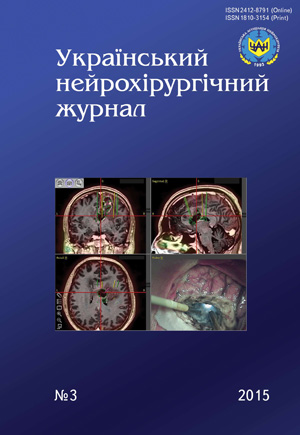A case of successful surgical treatment of a heavy penetrating mine blast brain wound
DOI:
https://doi.org/10.25305/unj.50275Keywords:
penetrating brain wound, diametric wound, penetrating wound, fragment mine blast wounds, surgical treatmentAbstract
This is an observation of a heavy penetrating fragment mine blast brain wound.
A fragment passed through the right and left cerebral hemispheres, caused heavy brain injuries, intracranial hematomas, blast skull base fractures and buttonhole vault fractures, falx and intracranial vessels injuries. The entrance wound was located in the left temporal area, and the exit wound in the right frontal area. The wound tract had signs of a penetrating diametric wound.
The penetrating wound manifested itself in the patient’s extremely critical condition, deep coma, and vital functions disorder. The study also revealed combined trunk and extremities injuries.
An extended initial surgical brain wound debridement was done, which included brain decompression, wound sanation, skull base and dural reconstruction, and tidal drainage.
The patient was transferred to a military hospital with improvements for further rehabilitation treatment. The timely and complete surgical treatment allowed for an effective management of intracranial hypertension and prevented pyoinflammatory complications.
References
1. Chaplyk V, Oliynyk P., editors. Nevidkladna viyskova khirurhiya [Emergency War Surgery]. Lviv: Nautilus; 2015. Ukrainian.
2. Clinical Practice Guidelines [Internet]. Available at: http://usaisr.amedd.army.mil/clinical_practice_guidelines.html.
3. Pedachenko EG, Danchin OG, Polishchuk ME, Tsymbaliuk VI. Orhanizatsiya nadannya spetsializovanoyi neyrokhirurhichnoyi dopomohy u viyskovyy chas (z•hidno oboronnoyi viyskovoyi doktryny): metod. Vkazivky [Organization of specialized neurosurgical care in wartime (according to defensive military doctrine): Guidelines]. Kyiv; 2014. Ukrainian.
4. Polishchuk NE, Starcha VI. Ognestrel'nyye raneniya golovy [Gunshot wounds of the head]. Kyiv: Ton; 1996. Russian.
5. Knuth T, Letarte PB, Ling G, Moores LE, Rhee P. Guidelines for field management of combat-related head trauma. New York; 2005.
6. Konovalov AN, Lihterman LB, Potapoov AA., editors. Cherepno-mozgovaya travma: klinicheskoye rukovodstvo [Traumatic brain injury: Clinical Guidelines]. Moscow: Antidor; 2001;2. Russian.
Downloads
Published
How to Cite
Issue
Section
License
Copyright (c) 2015 Andriy Sirko

This work is licensed under a Creative Commons Attribution 4.0 International License.
Ukrainian Neurosurgical Journal abides by the CREATIVE COMMONS copyright rights and permissions for open access journals.
Authors, who are published in this Journal, agree to the following conditions:
1. The authors reserve the right to authorship of the work and pass the first publication right of this work to the Journal under the terms of Creative Commons Attribution License, which allows others to freely distribute the published research with the obligatory reference to the authors of the original work and the first publication of the work in this Journal.
2. The authors have the right to conclude separate supplement agreements that relate to non-exclusive work distribution in the form of which it has been published by the Journal (for example, to upload the work to the online storage of the Journal or publish it as part of a monograph), provided that the reference to the first publication of the work in this Journal is included.









